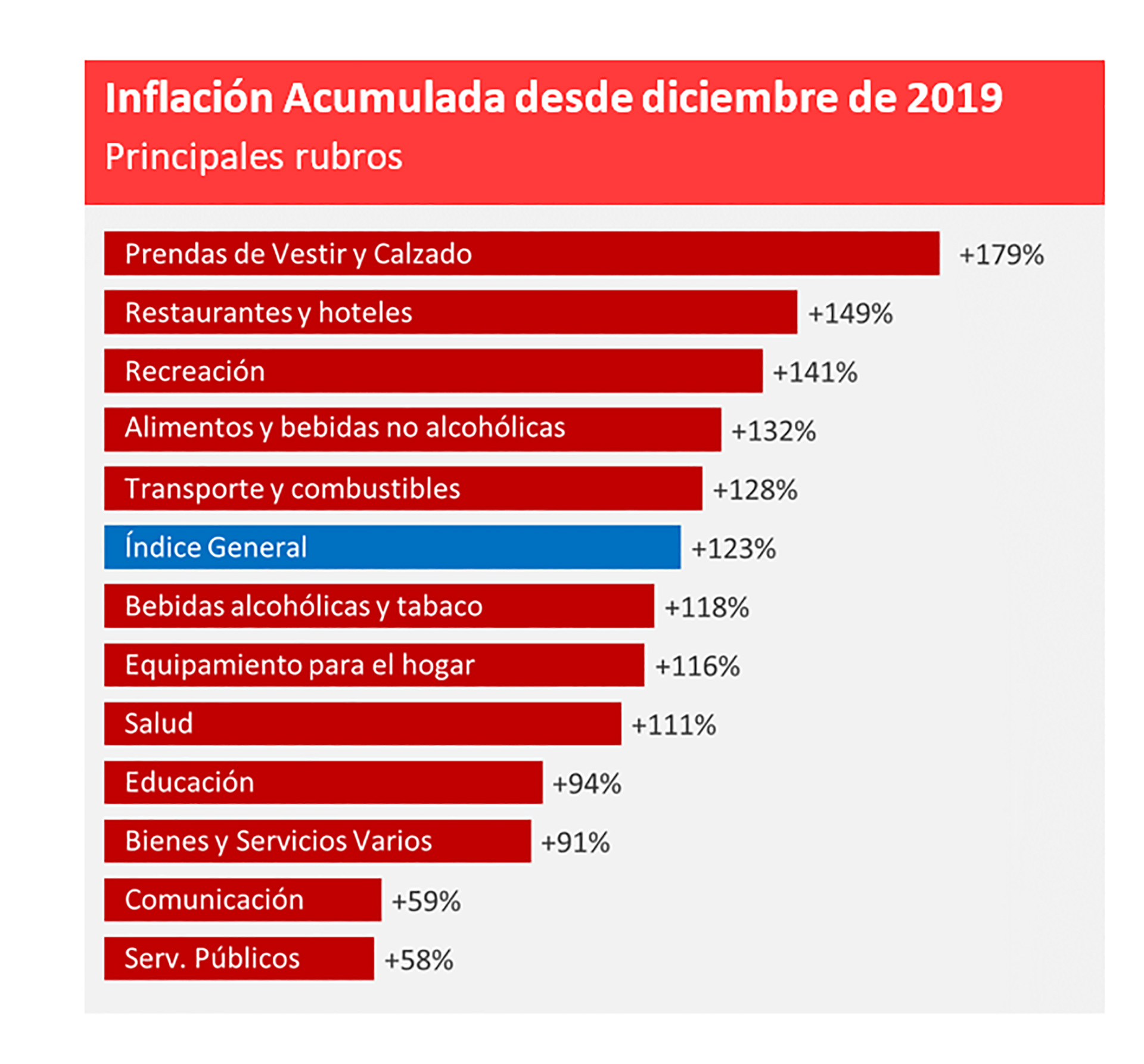
Since Alberto Fernández's assumption in December 2019, Argentina has accumulated an overall inflation of 123%, a level that no administration since 1991 had recorded in its first 26 months of office, according to a report by the Libertad y Progreso Foundation. Thus, the scourge of rising prices and the devaluation of the currency continues to affect Argentines despite the promise of the President, who stated that” on Friday the war against inflation begins in Argentina”.
According to the consultancy, the largest increase by category is seen in “Clothing and Footwear”, which rose 179%, almost 60 points higher than the general index.

It also observed an above-average increase in the food sector, which rose by 132% and is the item with the highest incidence in the Consumer Price Index (CPI) measured by the National Institute of Statistics and Censuses (Indec). “This phenomenon occurs even within the framework of the application of export duties and having implemented export closures,” emphasized the Foundation.
The analysis shows the price increase for the first 26 months of administration and therefore does not consider inflation in all presidential efforts. We must not lose sight of the fact that in the third year of the Cambiemos government there was inflation of 47.6% according to Indec, at that time the highest figure in the last 27 years.
Meanwhile, the Mediterranean Foundation stressed that in the context of stagflation that the Argentine economy has been going through in the last 10 years, inflation rises one step with each new government administration.
While during the second term of former president Cristina Fernández de Kirchner the price increase averaged 2.2% per month, annualized it reached 29.5%, and the cumulative figure for the first 26 months was 75.2%.
Regarding the management of former president Mauricio Macri, the Mediterranean Foundation explained that monthly inflation was 2.4%, annualized inflation was 32.8% and accumulated in the first 26 months reached 85%.
He added that so far during the term of President Alberto Fernández, monthly inflation is 3.1% on average, annualized inflation is 44.9% and the total for the first 26 months is 123 percent.
Eugenio Marí, Chief Economist of the Libertad y Progreso Foundation, referred to the statements of the head of state regarding inflation and in that regard, pointed out one of the causes of the price hike: “If you are going to keep your word, then on Thursday you must declare war on the fiscal deficit. Last year, the Central Bank's assistance to the Treasury to finance the deficit reached 3.7% of GDP, which is equal to $2 trillion pesos.”
“The government continues to bet on export control and prohibition to contain food prices, a far cry from the real battle against inflation,” said the economist.
Marí considered that these measures had already been implemented in the past, and “they always contributed to destroying exports, losing markets and bringing down registered employment levels. To top it off, as production is discouraged, at the end of the day there is less wealth and less supply of products, increasing poverty.”
In another order, Diego Piccardo, economist at the Foundation, stressed that items that have regulated prices in their composition are strongly lagging behind others. “This is clearly seen in utility prices that have been practically frozen since the government came into office and are now beginning to thaw. In this way, it is to be expected that, given that macroeconomic imbalances persist and regulated prices begin to adjust, inflation this year will be higher than 50.9% in 2021.”
It should be noted that inflation accelerated again in February, reaching 4.7% and thus accumulated a 52.3% variation in the last twelve months, according to Indec on Tuesday. The first two months of the year began this way with high price indexes, since in January the CPI had reached 3.9%, which is beginning to cast doubt on the feasibility of the official projection agreed by the Government and the IMF, which ranges between 38% and 48% for this year.
In this context, at the end of January 2022, market analysts that the Central Bank relieves every month projected that retail inflation for this year will stand at 55% year on year, which is about 2 percentage points higher than the previous survey.
The data comes from the Market Expectations Survey (REM) carried out by the monetary authority among consultants, banks, universities and other entities that forecast the main indicators of the economy.
KEEP READING:
Últimas Noticias
Debanhi Escobar: they secured the motel where she was found lifeless in a cistern

The oldest person in the world died at the age of 119

Macabre find in CDMX: they left a body bagged and tied in a taxi
The eagles of America will face Manchester City in a duel of legends. Here are the details

Why is it good to bring dogs out to know the world when they are puppies




